In: Curators Picks
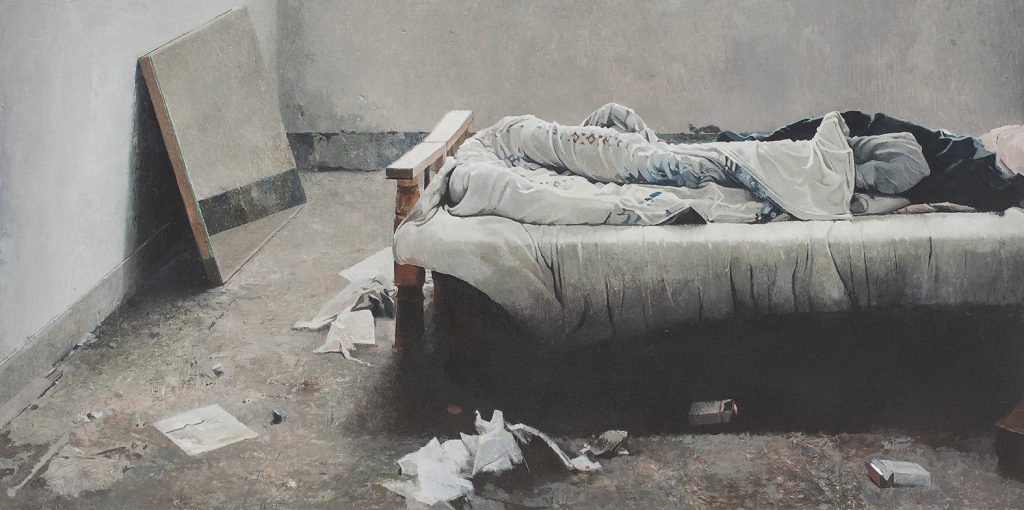
Joseba Sánchez Zabaleta | Room With Mirror
September 8, 2023Joseba Sánchez Zabaleta | Room With Mirror
“It is said that scattered through Despair’s domain are a multitude of tiny windows, hanging in the void. Each window looks out onto a different scene, being, in our world, a mirror. Sometimes you will look into a mirror and feel the eyes of Despair upon you, feel her hook catch and snag on your heart.
—————————————
In her world, there are so many windows. Each opening shows her an existence that’s fallen to her — some only for moments, some for lifetimes.”
(Neil Gaiman, from Season of Mists and Brief Lives, respectively)
Part of a larger series that engages with ‘footprints and memory’ and places now empty where the artist has recorded – or interpreted – the detritus of those who once existed in these spaces, Zabaleta’s paintings seem haunted. Though empty of people, their presences still suffuse the space, with an implication of absence, with someone missing that still is intrinsic to the atmosphere of his compositions.
His words : I wanted to paint the uninhabited buildings that I found in search of the memory of all those lives that I sensed should remain intact and detained in them. Waiting for something to happen, the empty buildings keep within their walls the trace of what has been lived between them. Somehow the fled love is imprinted on the plaster of its partitions. The silence of those deaf rooms falls through the walls, depositing itself between the joints in the pavement, next to the arid and dusty trace of time, among accumulated fragments, piled up by the wind in the corners.
One of the images I’ve shared in the full post is titled Marlom. Zabaleta offers the following meditation about this site, this painting, and the unknown person :
Of you there is only a name written in blue blood.
You thought it would be easy, that it would be just as they had told you. You thought that if others had achieved it, you would also achieve it. You thought while you were hiding, while the world was chasing you, what would be the best way not to be seen, to disappear, and you didn’t realize that nobody saw you, that you could have gone out on the road and walked, because those who are like you around here and you don’t look at them nor do you see them.
More of Joseba Sánchez Zabaleta’s fine paintings can be seen here.
~ Bart Gazzola
Read More
Annie Collinge | Table For One | 2020
August 25, 2023Annie Collinge | Table For One | 2020
With styling and art direction by James Theseus Buck and Luke Brooks of Rottingdean Bazaar, the Table For One series was created for Luncheon Magazine, featuring the model Tin Gao.
There are a number of places to stand (or crouch, on your knees with your head tucked under, like the resting chicken ‘downward dog’ work by Collinge) in considering Table For One.
Some are more light-hearted (when I first encountered Collinge’s performative scenes, I was having the type of day where staying at home in a banana bag or sitting stoically as a snug, solitary tomato was a comforting concept. Table For One might mean being grateful to be left alone, that day). Other responses may be darker : perhaps these are incongruously bright, vibrant metaphors for loneliness and separation. Eating alone at a table for one is interpolated as isolation – and assumed to be by reluctance not preference – which feeds (sorry) into the history of how eating with others and communal meals are lauded as linchpins of social structure. This is – of course – debatable, as it has a rank stench of nostalgia, like those who lament the myth of ‘family dinner.’
I offer this as someone who often goes to movies alone, or eats in restaurants alone, but have been told I’m ‘extroverted’ in other social interactions.
When considering art, I often cite what Jeanne Randolph describes as the ‘amenable object’ : it’s a ‘vessel’ that we pour our own experiences into, and thus construct its meaning in collaboration with the artist. Fashion falls within this, and is also a manifestation of art and social history : its a history we wear and perform. As with art history, it is sometimes subversive, sometimes explicit. Table For One exists within that space.
“Puppetry, dolls and larger-than-life costumes populate the images of London-based photographer Annie Collinge. Visual trickery abounds, as if Alice had just stumbled upon a magic potion in Wonderland, with scale (the very large and the very small) frequently distorted. The human body becomes a foil to its surroundings, offsetting imaginative surroundings that conjure the escapist storybooks of childhood. A head appears amidst a mushroom patch, or else a gloved hand clutches at a disembodied head. Like the best fairytales, these images carry as much menace as they do whimsy.” That quote is from an interview with Collinge : more of that conversation can be read here.
More of Collinge’s artwork (sometimes collaborative, sometimes solo) can be seen here and here.
~ Bart Gazzola
Read More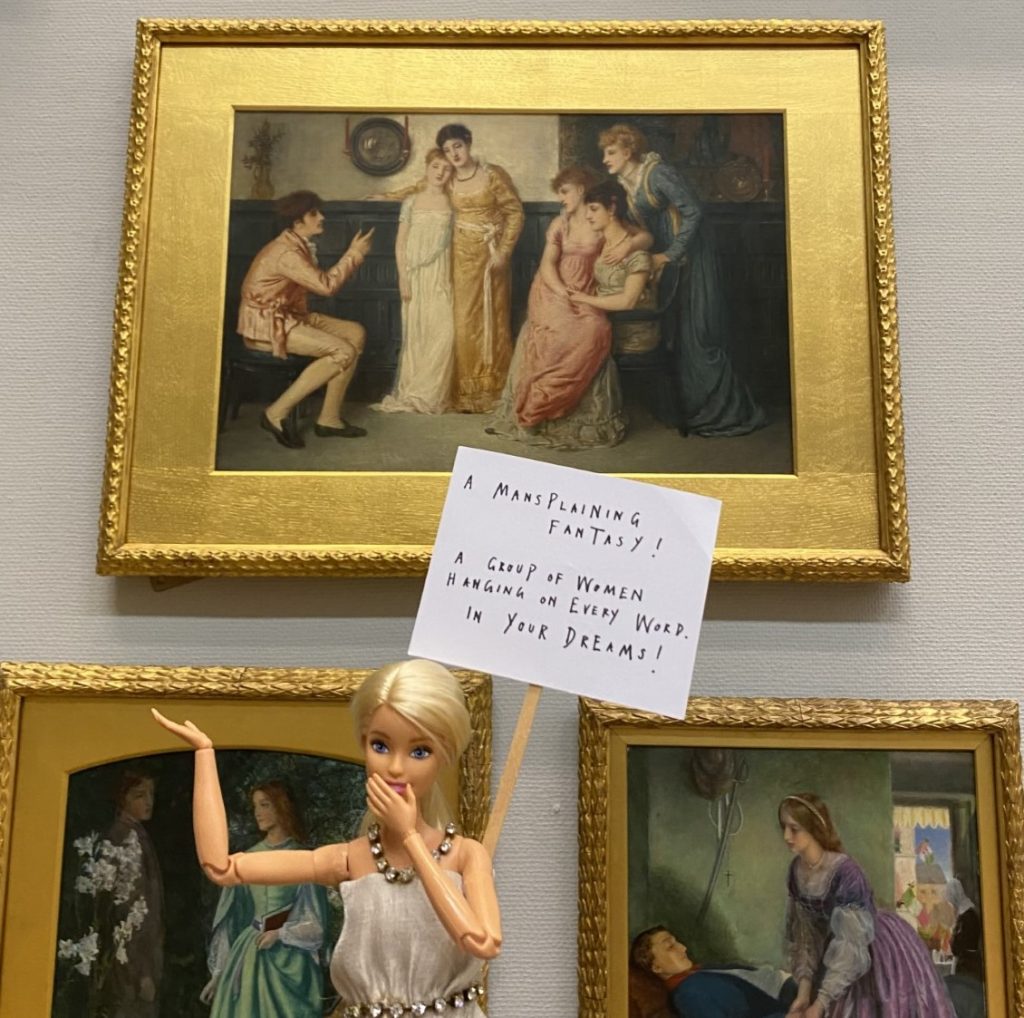
ArtActivistBarbie | Dr Sarah Williamson
August 11, 2023ArtActivistBarbie | Dr Sarah Williamson
Many years ago, when I was still working in art galleries, I was intimately involved with the first full ‘inventory’ of the Kenderdine Gallery’s art collection (now the College Gallery, at the University of Saskatchewan). This task involved documentation both visual and written, from shooting slides (yes, I am that old) and creating or augmenting artist and artwork files.
At one point, a coworker and I realized that there were more works by unknown artists than there were from female artists, let alone ‘contemporary’ ones : but I also remember an acquisitions meeting where yet another passel of karaoke modernist paintings by a second rate male artist were being considered for purchase (despite, as I pointed out, one of the people on the committee was the son in law of said artist, and we already had many works by this artist, and many more lesser imitations in this derivative genre. Unsurprisingly, I was asked to leave the meeting…).
I can’t help but feel nobody would be able to make ArtActivistBarbie leave, in a similar situation (yes, I am smiling as I type that). A performative persona of Dr Sarah Williamson, it feels appropriate to speak of ArtActivistBarbie as a person, unto herself, in this essay.
If you’re still swimming in that cesspool known as Twitter – sorry, ahem, ‘X’ – then perhaps you are already familiar with ArtActivistBarbie (@BarbieReports) who “has a finely tuned eye when it comes to calling out gender inequality in the arts, and she is not afraid of making a scene. Her provocative wit and fabulous wardrobe lend themselves to staged interventions, predominantly in art galleries and museums. Posing with her tiny, pithy placards, ArtActivistBarbie is photographed gently mocking or drawing attention to problematic exhibits and the images are shared with millions of Twitter users. She also challenges the biases inherent in so many curatorial labels and statements.
ArtActivistBarbie seeks to change the practices of these institutions, the bulk of whose collections have historically been commissioned and produced by men, representing many centuries of male power and privilege. Over 94% of artworks in publicly funded galleries [in the UK] are by white men and many objectify and demean women and girls. Making visible the lives and experiences of women and minority ethnic groups is vital for a more just and equal society.” (from here)
The origin of ArtActivistBarbie is thus : “The woman behind the project is Sarah Williamson, a senior lecturer in education and professional development at the University of Huddersfield. A few years ago, she was trying to find a way to engage her students with social-justice issues and feminist ideas, especially the problematic way women are portrayed in art. She wondered if Barbie, that plastic idealised woman, could become a vehicle for playful commentary on the “patriarchal palaces of painting”. Soon Williamson was gathering a doll army, clothing it in pieces handmade by her feminist mother in the 1970s, with new additions created by her sister. She handed each of her students a Barbie doll and a blank placard on a lollipop stick, then set them loose in Huddersfield Art Gallery.
The resulting mini-protest signs stopped visitors in their tracks, and the photographs of Barbie’s protests drew plenty of notice back in Williamson’s office: “I realised I had something which attracted everyone’s attention and catalysed conversations about how women are portrayed and represented not only in art, but society in general.”” (from The Guardian)
It’s also necessary to consider how “museums are somewhat newly self-reflexive about their role in shaping the culture and the discourse, and are working hard to stay relevant and expand the canon—and to grow their audiences.” (That’s from a recent article in ArtNews that appropriately decries the slipshod ‘critique’ offered by the Brooklyn Museum’s exhibition Pablo – matic – and although ArtActivistBarbie seems to ‘shoot from the hip’, her aim is more accurate, and considered, in the larger discourse of whom and what cultural institutions serve – and don’t….)
Much more about ArtActivistBarbie’s caustic yet comedic commentary (comedy, it has been said, is just rage in fancy dress, and Barbie has no shortage of snazzy outfits) can be enjoyed here. There are a number of interviews with Dr Williamson that are as educational as they are engaging.
~ Bart Gazzola
Read More
Tish Murtha | Elswick Kids | 1978
August 4, 2023Tish Murtha | Elswick Kids | 1978
All we wanted was everything. All we ever got was coal.
(Bauhaus, from the album The Sky’s Gone Out, 1982)
Patricia Anne “Tish” Murtha (1956 – 2013) was a British photographer best known for her images of working class life in Newcastle upon Tyne and the North East of England. Murtha’s work is a raw documentation of these communities – and often youth within these social groups – at a time when British Prime Minister Margaret Thatcher waged war on her own citizens, embracing a neo – liberal cruelty that is like a virus whose symptoms can be still seen in contemporary post Brexit Britain.
The images captured by Murtha evoke notions of a ‘third world’ country, with the scenes of desolate and despairing youth amidst a wasteland that – being shot in black and white – emit a hopelessness that reaches across the decades. Or perhaps it is simply combining with the contemporary desperation among working class communities in these places now.
From here : “In 1976, aged 20, Tish left home to study at the famous School of Documentary Photography at The University of Wales, Newport under the guidance of Magnum member David Hurn.
She took many photos in Newport, including The former Prime Minister James Callaghan opening up a new stretch of the M4, as well as documenting Aubrey Hames’ year as Mayor of Newport in the Queens Silver Jubilee year (1977-1978). Tish also worked with the South Wales Argus during this time and photographed the local election campaigns.
When she returned to Newcastle, she began to document the lives of her friends and family and numerous other projects.
Tish’s work was often concerned with the documentation of marginalized communities from the inside. She invested her time building relationships of trust, which allowed her access to different parts of the communities that she photographed. Her approach was informal, generating an understanding of what she was doing by giving copies of her photos to the people in them. The young people she photographed as part of the Youth Unemployment and Juvenile Jazz Band exhibitions showed how tenacious, resourceful, clever and resilient they were (and had to be) – Tish was always fiercely protective of them.
She felt she had an obligation to the people and problems within her local environment, and that documentary photography could highlight and challenge the social disadvantages that she herself had suffered.”
Three books of her photographs have been published posthumously : these are Youth Unemployment (2017), Elswick Kids (2018) and Juvenile Jazz Bands (2020).
More of Tish Murtha’s work and her life (as her daughter is maintaining her archive and ensuring her mother’s work is given its appropriate place in terms of history and art) can be seen here.
~ Bart Gazzola
Read More
Dimitri Tsykalov | MEAT | 2007 – 2008
July 28, 2023Dimitri Tsykalov | MEAT | 2007 – 2008
It’s not a new idea that firearms make acts of violence ‘too easy’, almost ‘antiseptic’, as they minimize the necessary physical contact intrinsic to other acts of brutality. This is an idea that’s been raised about technology since we began using it to kill each other.
(At the risk of seeming flippant, I must also inject a quote that came to mind when I first encountered images of Tsykalov’s MEAT : Invariably, the first question asked about a new technology is, “Can this make killing less of a hassle?” The second being, “Can I have sex with it?”…)
The implicit ‘removal’ or ‘remoteness’ (I’m reminded of the ski pole scene from Timothy Findley’s The Wars, for example, where the firearm and act of murder almost seem separate from the character himself) makes it almost a ‘trivial’ or ‘throwaway’ action to fire a gun.
Dimitri Tsykalov’s MEAT works offer a counter to that, in a grotesque manner that is excessive : I’ve debated writing about Tsykalov’s ‘armaments’ for a while, unsure if they’re too flippant, or too horrifying, or a combination of both that is as unpalatable as gripping cold flesh while your hands are stained and overrun with effluvia…
These works don’t pretend to an aesthetic distance (like in Serrano’s work, or some other artists I’ve talked about here who – like myself, when I worked with fat, bone and meat for over two decades – are interested in creating inappropriately beautiful artwork) : I feel that Tsykalov takes pleasure in our revulsion and wants to evoke it from us, and considering what he’s ‘butchering’ the meat, flesh and bone into, this is not inappropriate. There’s a swagger here, a bravado that intends to make us ill. Meat and guns are, after all, metaphors for penises or toxic masculinity, and Tsykalov alludes to that (even with the titles that reference specific guns).
Tsykalov, in creating work that intersects with brutality and our capacity for it, as a species, has taken an opposing artistic path to someone like Ralph Ziman with The Ghosts Project (a past Curator’s Pick you can see here).
Tsykalov’s own words : “In these pictures I recognize the murderers within me, I recognize love and death within me; in these pictures I recognize my flesh as the cannon fodder it is and will be for the rest of my life. In contrast the secondary meat in these shots – the one that rots and that kills, the animal meat that is used to create the fleshy weapons – seems unscathed, sanguine and elegiac. It is incredibly alive, it is cannon flesh and we are already mortal.”
Dimitri Tsykalov was born in Moscow (1963) where he attended Polygraphic Institute of Moscow (1982-1988). He currently lives and works in Paris.
More of his work can be seen here.
~ Bart Gazzola
Read More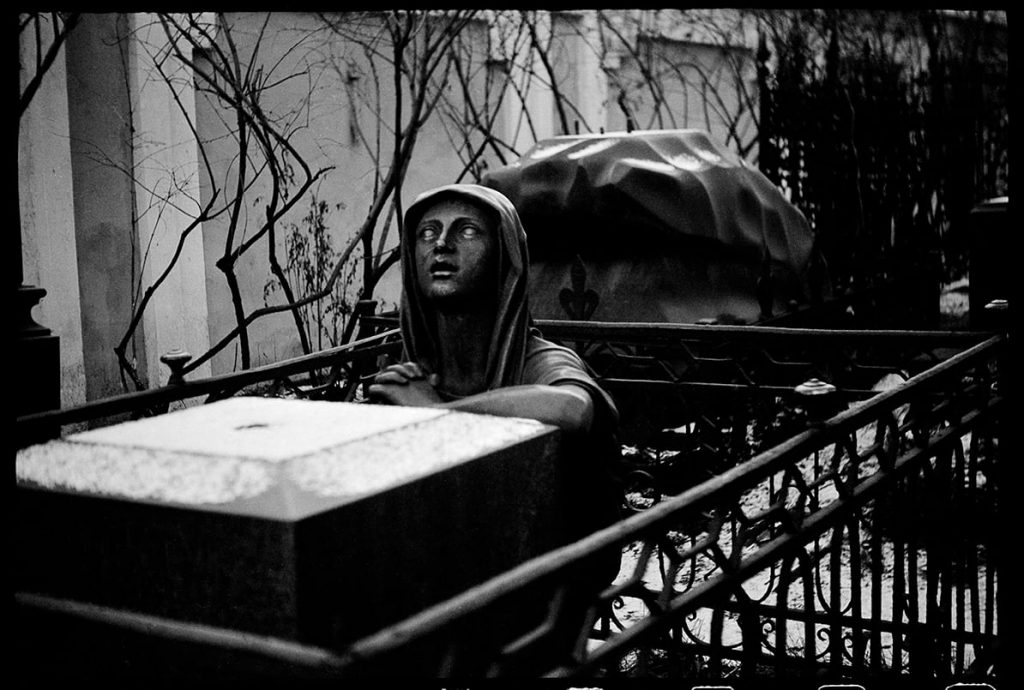
Saint Alexander Nevsky Monastery, Leningrad, USSR | Masha Ivashintsova |1977
July 21, 2023Saint Alexander Nevsky Monastery, Leningrad, USSR | Masha Ivashintsova | 1977
I was not born
to amuse the
Tsars.
— Alexander Pushkin
I loved without memory: is that not an epigraph to the book, which does not exist? I never had a memory for myself, but always for others.
— Masha Ivashintsova
Masha Ivashintsova has been described as a ‘Russian Vivian Maier‘ as she took so many photographs – creating a world, in a way, of her city – in her lifetime but most of them have only been shared since her death. Her eye for contemporary life under the Soviet regime – especially in St. Petersburg later Petrograd later Leningrad then again St. Petersburg (the shift in name and what that entails in the socio political sphere is a good place to stand, when considering Ivashintsova’s photographs) – was an honest and personal portrait of her life and times. One might argue that the veracity of these experiences captured with her lens were – are – so honest and powerful that we can understand why she held them to herself for so long. Her own personal history was also painful, and that was surely a factor, too.
Or, perhaps as I allude to with the quote from Pushkin, autocratic, authoritarian societies prefer facile propaganda and punish uncomfortable truths….
Ivashintsova (1942 − 2000) was a photographer based in Saint – Petersburg (then Leningrad, in the USSR) “who was heavily engaged in the Leningrad poetic and photography underground movement of the 1960−80s. Masha photographed prolifically throughout most of her life, but she hoarded her photo-films in the attic and rarely developed them. Only when her daughter Asya found some 30,000 negatives in their attic in 2017 did Masha’s works become public.”(from here)
“Struggling with life under Communism, by the mid-1980s Masha was committed to a mental hospital against her will, as a way to get her in line with the USSR’s philosophies. Working throughout her life as a theater critic, librarian, cloakroom attendant, design engineer, elevator mechanic, and security guard/riflewoman, she was a chameleon, always camouflaging her inner artist. Only through her diaries and photographs was she able to show her true self.”
A fine article – and interview – with her daughter Asya Ivashintsova-Melkumyan can be enjoyed here. A site devoted to Ivashintsova’s amazing archive can be seen here : as well, there is a social media page that shares her work at regular intervals here.
~ Bart Gazzola
Read More
Yuka Yamaguchi | Inseparable | 2006
July 14, 2023Yuka Yamaguchi | Inseparable [離れられない] | 2006
If there is love, smallpox scars are as pretty as dimples.
(Japanese proverb)
There is a simple elegance to Yagmaguchi’s work that sometimes belies the visceral content. I was lucky enough to experience her work in person, in an exhibition years ago that purported to showcase contemporary Saskatchewan artists. There were too many artists in the show, some of middling ‘quality’, but Yamaguchi’s unique style and subject matter was a high point of that exhibition.
Her use of very simple tools is perfectly matched to the illustrative nature of her images, which are as much about storytelling as a disciplined but playful aesthetic.
The title of this work can also be translated from Japanese as ‘Can’t Leave’ : but I don’t interpret that in a negative context, and still read this work as a more bodily or corporeal valentine’s card. The rawness is just another way of depicting the intensity of the feelings of being ‘inseparable.’
Yuka Yamaguchi is a self-taught visual artist from Kobe, Japan who has lived in Saskatoon since 2005.
Colour pencils and paper are her preferred medium as these tools allow for strong colors even though they are fragile and delicate. Yamaguchi “draws intuitively as she sees an image appear on paper and keeps adding images like a puzzle.”
More of Yuka Yamaguchi’s artwork can be seen here.
~ Bart Gazzola
Read More
Afarin Sajedi | Chef Offer | 2013 – 2014
July 6, 2023Afarin Sajedi | Chef Offer | 2013 – 2014
“You will eat less than you desire and more than you deserve.”
(from The Menu, 2022)
The works in Sajedi’s Chef Offer series have evocative if direct names (I prefer to say ‘names’ over artwork titles in deference to her figures, with their poise and power).
These includeThe Soldier (2013), Like A Queen (2013) and Like A King (2013). The header image – breaking this pattern – is simply Fork (2013). The latter seems less stoic and more a warning to the viewer meeting her gaze….
Even the superficially absurd head pieces that her women wear are less amusing than unsettling in their elaborate nature: the pale faces, flushes on the cheeks and uncanny presence of the women in Chef Offer inspire anxiety more than amusement…
I recently rewatched The Menu, a horror film about the pretentious restaurant ‘scene’ that is rife with dark humour. Many of the harsh if unflinching ideas in The Menu are present in another horror film that dryly mocks the art world : Velvet Buzzsaw (2019). With both of these films I have rarely laughed so hard – and appropriately – at horror. Both of these films came to mind in considering Sajedi’s Chef Offer series.
The women that Sajedi ‘offers’ us seem to have an affinity to the Menu character Elsa, whose inscrutable, amused hint of a smile portends nothing but appropriate suffering for the ‘diners.’ It’s Elsa’s words I opened this essay with : and the exchanges of dialogue in The Menu offers a place to stand and consider Afarin Sajedi’s women in Chef Offer.
An example (and try to read this without picturing one of Sajedi’s women speaking as Chef Slowik, here):
Chef Slowik: So, the question is, do you wanna die with those who give, or with those who take?
Margot: But I die either way? It’s arbitrary.
Chef Slowik: No, it’s not arbitrary. Nothing in this kitchen is arbitrary. Please pick. These decisions are important, and, uh, our menu is strictly timed. In 15 minutes, I’ll take a break between courses, and that is how long you have to decide. It’s our side or theirs. In the meantime, please return to your seat. The next dish is exquisite.
Afarin Sajedi was born in 1979 in Shiraz and relocated to Tehran in Iran to study at Tehran Azad University where she earned a degree in graphic design. Afarin’s paintings are marked by a melding of technique and creativity, and often powerful in their presentation. Her subjects include theatrical characters, sometimes with overtly colourful, almost clownish faces, that are inspired by Japanese theater in tandem with symbols of western religious art that contrast and collide with the contemporary world. Afarin’s “characters are usually royal, proud, and silent with a deep look.” (from her site)
More of her work can be seen here and her IG is here.
~ Bart Gazzola
Read More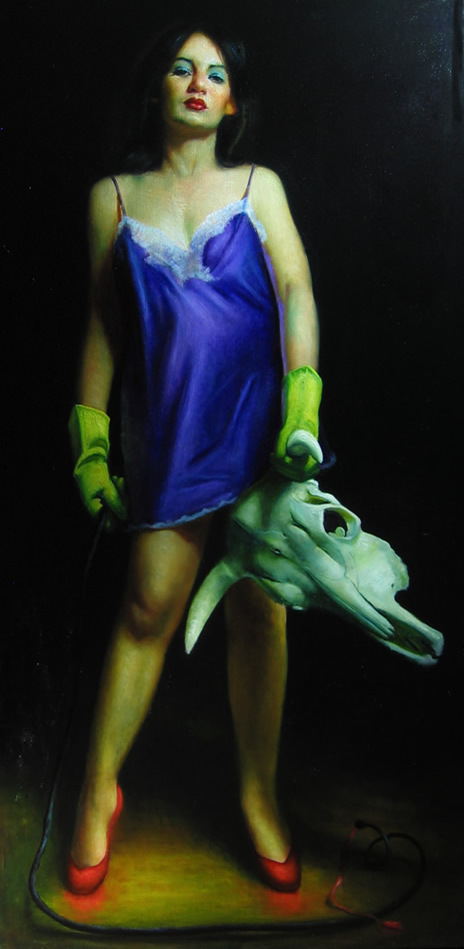
Rose Freymuth-Frazier | Woman Fighting Bull | 2007
June 30, 2023Rose Freymuth-Frazier | Woman Fighting Bull | 2007
I am tempted to simply comment that this is my offering – my criticism, in a visual manner – of the online debate around the exhibition at the Brooklyn Museum that purports to explore the misogyny of Picasso and what might be the inflation of his genius in the Western art canon. If you’re unfamiliar with what I’m referring to by this comment, this link may help.
There is a carnivalesque aspect – and attitude, with her figures – in much of Freymuth-Frazier’s artwork. Recurring motifs make her paintings like a story, and the gazes and stances have a cinematic quality. Humour – often dark, or with an amusing caustic edge – is also present in her rendered scenes.
I enjoy the elements in this that conflict and conflate with the title : the yellow cleaning gloves (when I see these, I can almost smell the rubber of them), the rich red heels that seem almost to bleed colour onto the floor beneath them, the fine negligee matching the eye shadow, and all offset by the ‘trophy’ of the bull’s skull gripped in a cavalier and triumphant manner. If some of Artemisia Gentileschi‘s tableau of the (appropriate, perhaps) beheading of outrageous men comes to mind, that is only fitting.
Freymuth-Frazier’s woman looks as though she just dealt with a situation that though not her fault became her responsibility and will brook no complaints – or any of your ‘bull’, if I may engage in a pun. It’s a look familiar to us from some of the women in Romina Ressia‘s metaphorical portraits. Less flippantly, Freymouth-Frazier’s figures are the children of Paula Rego‘s characters, too : sometimes presenting uncomfortable but unapologetic experiences, direct and engaging in formal and conceptual ways. There’s a description of Rego’s work that applies very well to Freymouth-Frazier’s too : “Her paintings are a cryptic glimpse into an intimate world of personal tragedy, perverse fantasies and awkward truths.”
Rose Freymuth-Frazier has studied at the Art Students League of New York and the New York Academy of Art.
From her site :
“Rose’s mother and grandmother were both artists. Her work draws from a deep connection to the women who came before her as well as German art and culture passed down through her German Jewish refugee family, particularly that which was labeled as “degenerate” art. Her large-scale figurative oil paintings draw on a range of sources from intimate moments with loved ones and her Persian cat, to the detachment of pinup and soft porn, stock photography, and advertisements. Through an exploration of the subconscious, she depicts themes both personal and universal.
Her work has been exhibited internationally, and is included in private collections around the world, including The Bennett Collection of Women Realist, Collection of Gillian Flynn, Collection of Milane Duncan Frantz and the Collection of Michele Peterson.”
Her site and much more of her fine work can be enjoyed here and her IG is here.
~ Bart Gazzola
Read More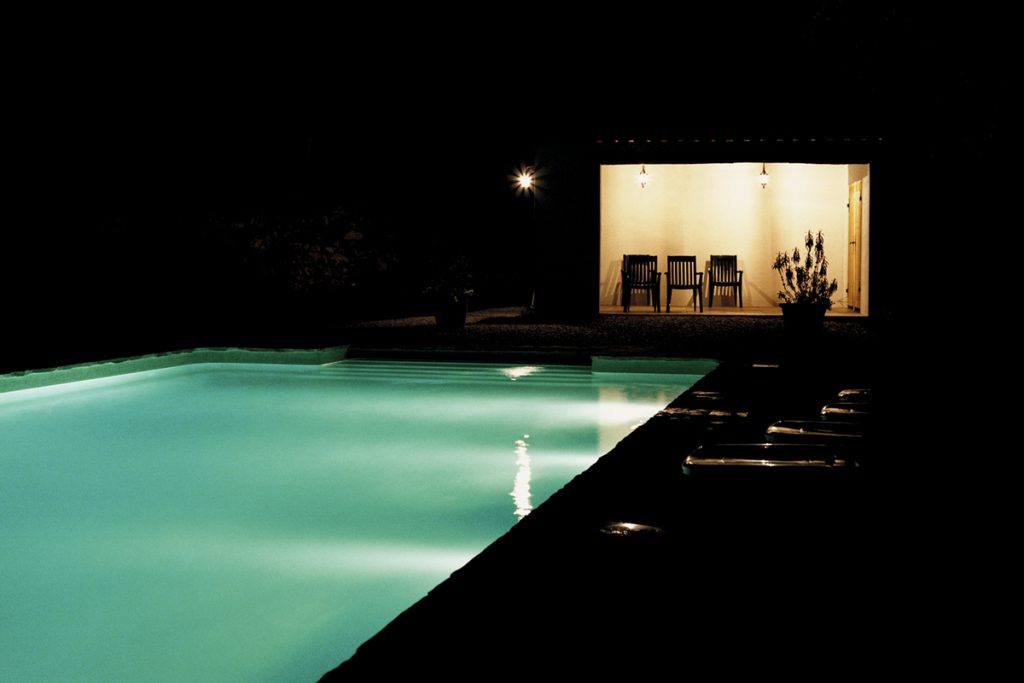
Alys Tomlinson | Dead Time | 2004 – 2006
June 23, 2023Alys Tomlinson | Dead Time | 2004 – 2006
“I like to remember things my own way.”
“What do you mean by that?”
“How I remember them. Not necessarily the way they happened.”
(from Lost Highway)
I’ve recently begun rewatching the third season of Twin Peaks (I mention this as Alys Tomlinson has spoken of Dead Time with allusions to the painter Edward Hopper but also that ephemeral notion of the Lynchian landscape): there’s a scene where Shawn Colvin’s version of Viva Las Vegas is a soft and enchanting soundtrack to the unfolding scene, and I happened to be listening to that song as I was perusing Tomlinson’s Dead Time series online. Vegas is, they say, a place where time is fluid, or can be lost or doesn’t exist in the same manner as elsewhere….
Tomlinson’s scenes are more Lynch’s Mulholland Drive or Lost Highway than Twin Peaks, with harsh artificial light casting edged shadows and revealing a sinister tableaux. Some critics have spoken of how time in the Lynchian universe – especially in Twin Peaks – is non linear, and Tomlinson’s images have an eerie familiarity (I’ve also travelled long distances by car and spent evenings in motels that, in recollection, blur together into one continuous banal experience).
There’s an element of the same unsettling darkness and emptiness that Steve Laurie employs in some of his images that also invite us to see them as film stills and create our own narratives for them. Tomlinson’s ‘America’ is empty, hard and bright. Swimming pools – usually sites of social interaction and enjoyment – are harbingers that seem more nefarious, here.
“For the past few years Alys has been photographing empty swimming pools at night in the UK and abroad. The images explore a twilight world of the in-between: a blurring of day and night, light and dark, the open and the enclosed, plenitude and absence. Whether municipal or members only, the pool is a space shaped by its patrons. Captured out of use, these familiar spaces stand outside time. Curved light breaks up the horizontal rigour. The comfort of transparency gives way to reflection and shadow. What is cedes to what could be, and the ordinary is transformed. The geographical location of each swimming pool is kept secret. Shot at dusk or at night, the pools take on a detached, almost melancholy, emptiness, and suggest a sinister feeling that something has happened, or is about to happen.” (from here)
Alys Tomlinson’s site can be seen here (she’s an award winning photographer and the diversity of her work speaks to her acumen with a lens, both formally and conceptually) and her IG is here. She has produced a book of these images, as well.
~ Bart Gazzola
Read More
Recent Comments